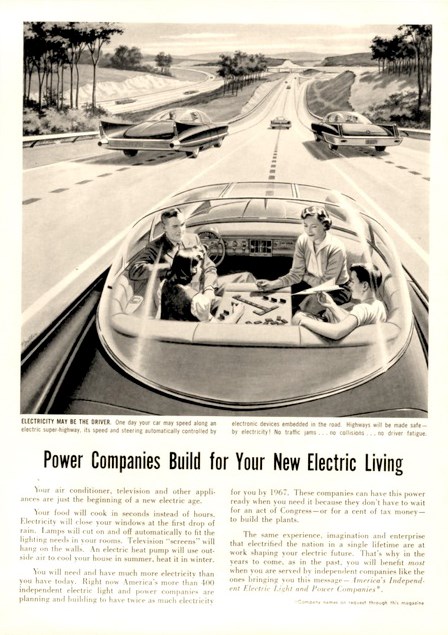Self-driving cars have been just around the corner since, well, the 1950s apparently.
There is this great advertorial from the Electric Light & Power Co. circa 1957 in which a perfect nuclear family plays a board game while the “electric superhighway” whisks them off to wherever it is perfect nuclear families went in the 1950s, Yellowstone probably.
This ad gets trotted out whenever new news about self-driving cars comes about and I love it because the cars are basically 1950s cars with dome tops and surround seats.
The latest news was a bold announcement by Tesla Motors owner and visionary Elon Musk that his Model S electric cars will be self-driving by this summer.
In fact, the technology has been around for a while. Step one was cruise control. I can’t even remember a time when it was not available.
Self-parking cars first hit the market in 2006 with the Lexus LS460. BMW, Volkswagon, Mercedes Benz and Ford followed suit. It is now practically standard equipment on Fords.
Crash avoidance systems are also available on many cars now. They use the same self-awareness as parking assist to anticipate a crash and apply the brakes or turn the wheels to keep or get out of trouble.
Computers will eventually probably be better drivers than most humans because they can do more than one thing at a time—contrary to popular belief people don’t actually multitask (see “Multitasking: The bane of productivity,” Thinking Critically, Yorkton This Week, January 22, 2014)—they can see in our blind spots, they think much faster than we do and they do not get distracted.
Most people don’t realize it, but there are already autonomous cars on public roads. California, Florida, Michigan and Nevada, as well as, Washington, D.C. specifically allow automobile manufacturers to test their vehicles on public streets. At least three are taking advantage of it, Audi, Google (yes, that Google) and Tesla. Others such as Mercedes Benz, Honda and Infiniti have cars that are currently capable of driving themselves, but the companies have built in safeguards against a customer actually taking their hands of the wheel.
In fact, it is not really the technology that is holding up the dream of hitting the highway, taking your hands of the wheels and feet off the pedals and reading the newspaper. It is the regulatory regime.
I suspect there will also be some fairly serious psychological roadblocks. By nature, we tend to like being in control. For many people, me included, it is easier to be the driver than a passenger. Professional athletes never seem to be as nervous as their family members with big stakes on the line.
Nevertheless, the era of the self-driving car, may finally, and truly, be just around the corner.
There is much legal discussion going on at the moment as to whether or not autonomous cars are illegal on the roads.
Musk does not think so. Neither does Google. Other manufacturers seem to be taking a wait-and-see approach.
Most companies see the liability issues as simply too risky, but Tesla may just have the gumption to test the laws.
Alexis Georgeson, a spokesman for Tesla, told the New York Times there was “nothing in our autopilot system that is in conflict with current regulations.”
However it is not just the company that must be willing to push the envelope. Individual Tesla customers will have to be willing to test the legislation.
I am sure there are drivers willing to do so. I don’t know that I would be one of them no matter how exciting the idea is. If something did happen being in a liability argument with any of the big auto manufacturers is not a place I’d want to be.




